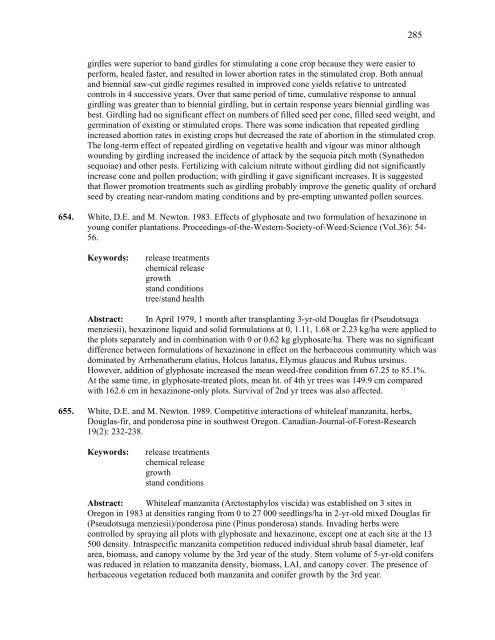IntensIve sIlvIculture - Forest Science Labs - Research Network ...
IntensIve sIlvIculture - Forest Science Labs - Research Network ...
IntensIve sIlvIculture - Forest Science Labs - Research Network ...
Create successful ePaper yourself
Turn your PDF publications into a flip-book with our unique Google optimized e-Paper software.
285<br />
girdles were superior to band girdles for stimulating a cone crop because they were easier to<br />
perform, healed faster, and resulted in lower abortion rates in the stimulated crop. Both annual<br />
and biennial saw-cut girdle regimes resulted in improved cone yields relative to untreated<br />
controls in 4 successive years. Over that same period of time, cumulative response to annual<br />
girdling was greater than to biennial girdling, but in certain response years biennial girdling was<br />
best. Girdling had no significant effect on numbers of filled seed per cone, filled seed weight, and<br />
germination of existing or stimulated crops. There was some indication that repeated girdling<br />
increased abortion rates in existing crops but decreased the rate of abortion in the stimulated crop.<br />
The long-term effect of repeated girdling on vegetative health and vigour was minor although<br />
wounding by girdling increased the incidence of attack by the sequoia pitch moth (Synathedon<br />
sequoiae) and other pests. Fertilizing with calcium nitrate without girdling did not significantly<br />
increase cone and pollen production; with girdling it gave significant increases. It is suggested<br />
that flower promotion treatments such as girdling probably improve the genetic quality of orchard<br />
seed by creating near-random mating conditions and by pre-empting unwanted pollen sources.<br />
654. White, D.E. and M. Newton. 1983. Effects of glyphosate and two formulation of hexazinone in<br />
young conifer plantations. Proceedings-of-the-Western-Society-of-Weed-<strong>Science</strong> (Vol.36): 54-<br />
56.<br />
Keywords: release treatments<br />
chemical release<br />
growth<br />
stand conditions<br />
tree/stand health<br />
Abstract: In April 1979, 1 month after transplanting 3-yr-old Douglas fir (Pseudotsuga<br />
menziesii), hexazinone liquid and solid formulations at 0, 1.11, 1.68 or 2.23 kg/ha were applied to<br />
the plots separately and in combination with 0 or 0.62 kg glyphosate/ha. There was no significant<br />
difference between formulations of hexazinone in effect on the herbaceous community which was<br />
dominated by Arrhenatherum elatius, Holcus lanatus, Elymus glaucus and Rubus ursinus.<br />
However, addition of glyphosate increased the mean weed-free condition from 67.25 to 85.1%.<br />
At the same time, in glyphosate-treated plots, mean ht. of 4th yr trees was 149.9 cm compared<br />
with 162.6 cm in hexazinone-only plots. Survival of 2nd yr trees was also affected.<br />
655. White, D.E. and M. Newton. 1989. Competitive interactions of whiteleaf manzanita, herbs,<br />
Douglas-fir, and ponderosa pine in southwest Oregon. Canadian-Journal-of-<strong>Forest</strong>-<strong>Research</strong><br />
19(2): 232-238.<br />
Keywords: release treatments<br />
chemical release<br />
growth<br />
stand conditions<br />
Abstract: Whiteleaf manzanita (Arctostaphylos viscida) was established on 3 sites in<br />
Oregon in 1983 at densities ranging from 0 to 27 000 seedlings/ha in 2-yr-old mixed Douglas fir<br />
(Pseudotsuga menziesii)/ponderosa pine (Pinus ponderosa) stands. Invading herbs were<br />
controlled by spraying all plots with glyphosate and hexazinone, except one at each site at the 13<br />
500 density. Intraspecific manzanita competition reduced individual shrub basal diameter, leaf<br />
area, biomass, and canopy volume by the 3rd year of the study. Stem volume of 5-yr-old conifers<br />
was reduced in relation to manzanita density, biomass, LAI, and canopy cover. The presence of<br />
herbaceous vegetation reduced both manzanita and conifer growth by the 3rd year.
















